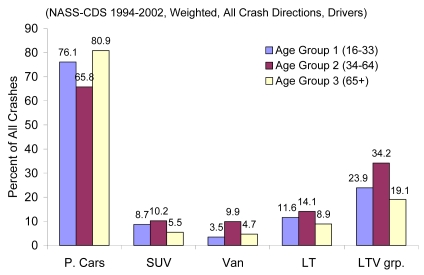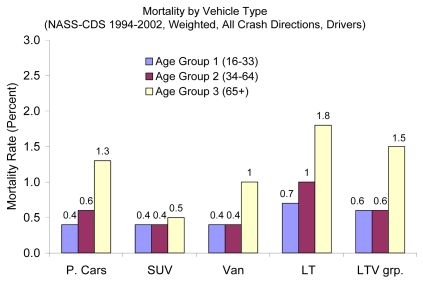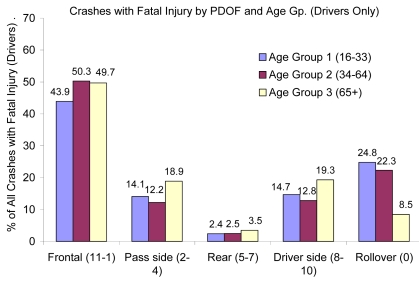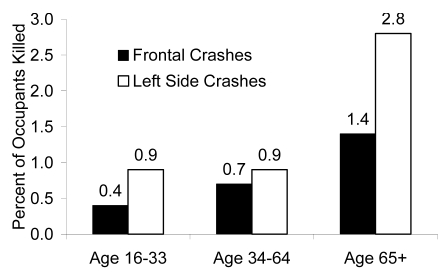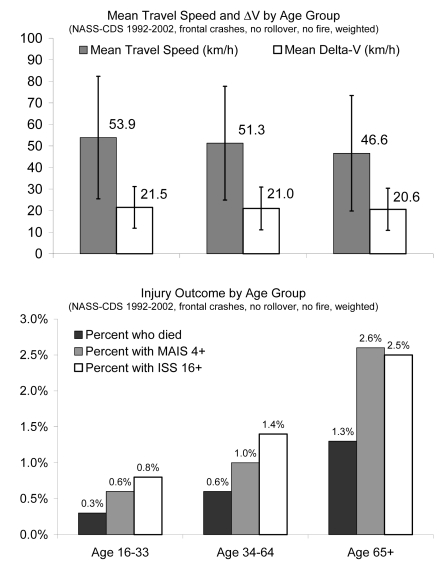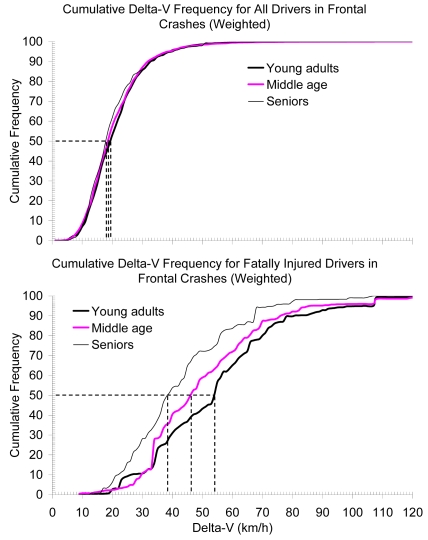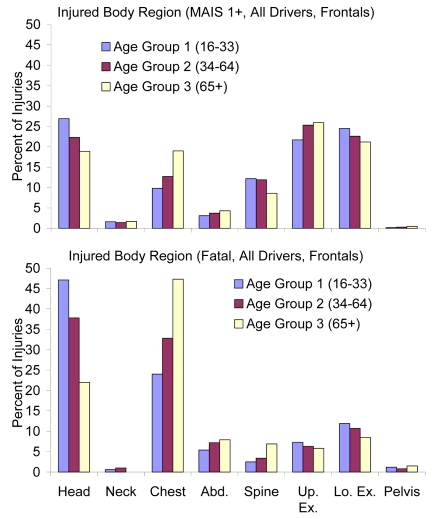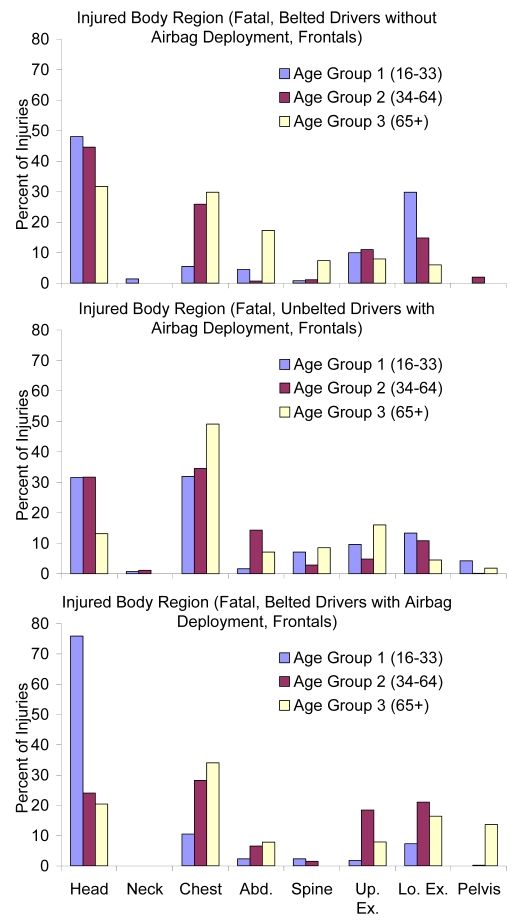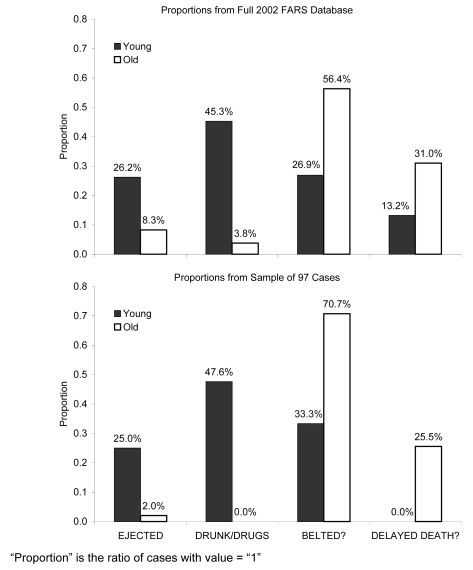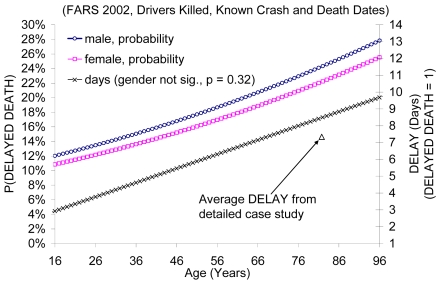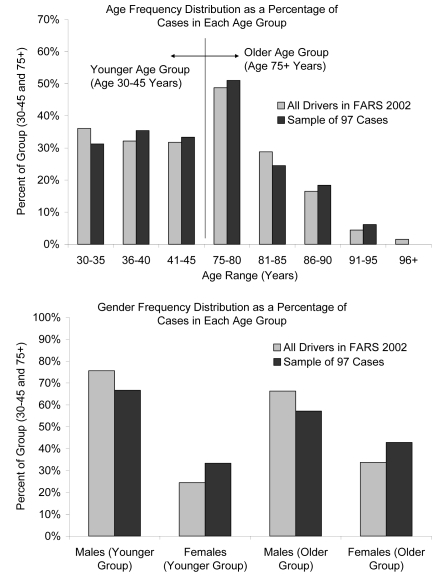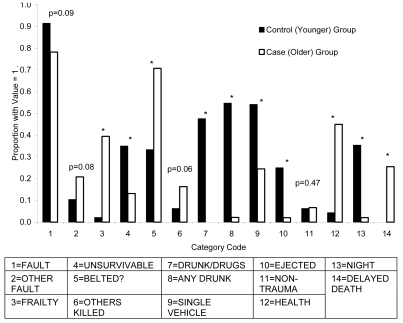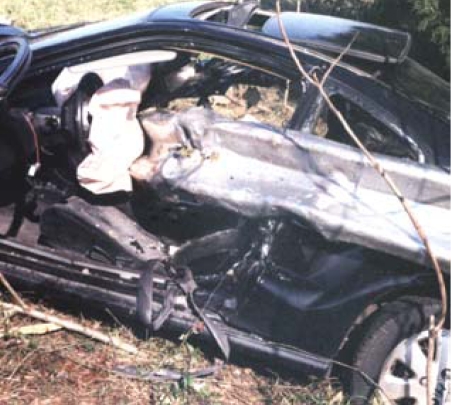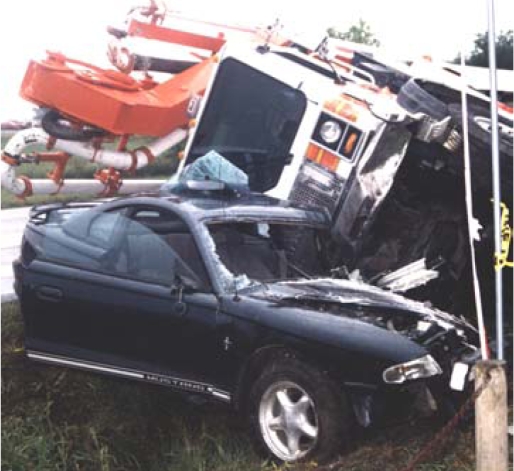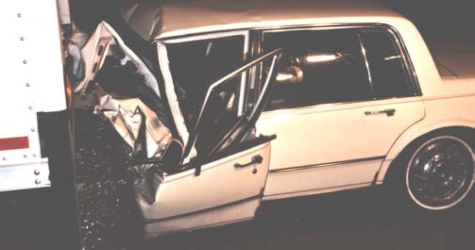Abstract
This study describes the fatal crash experiences of older drivers. Data from two U.S. databases (NASS-CDS and FARS) were used. Several crash, vehicle, and occupant characteristics were compared across age groups, including vehicle type, crash direction (PDOF), severity (ΔV), and injured body region. A sub-set of 97 fatally injured drivers was chosen for a detailed case study. The mean travel speed, ΔV, and airbag deployment rate decreased significantly with age (p<0.001 unless noted). Mortality rate increased significantly with age. Older drivers killed were significantly more likely to die of a chest injury (47.3% vs. 24.0% in youngest group) and less likely to die of a head injury (22.0% vs. 47.1% in youngest group). Older drivers were more likely to die at a date after the crash date (“delayed death”), as were males (p=0.003). A 16-year-old driver had a 10.8%–12.0% probability of delayed death, while a 75-year-old had a 20.7%–22.7% probability. For those having a delayed death, the length of the delay increased significantly with age (2.9 days for age 16 vs. 7.9 for age 75). A subjective assessment of the case files indicated that frailty or a pre-existing health condition played a role in 4.3% of the younger drivers’ deaths, but 50.0% of the older group.
Life expectancy is increasing throughout the developed world. By 2030, 25% of the U.S. population will be age 65 or older (OECD 2001) and the average age of the U.S. population is projected to increase through 2100 (2000 U.S. Census). Kent et al. (2003) projected that, from 1996 to 2012, passenger car drivers will sustain approximately 50,000 additional serious injuries simply because society is aging and becoming more frail.
Recognizing this population shift, the U.S. National Highway Traffic Safety Administration (NHTSA) (1993) identified eight Problem Identification Projects – deficient research areas that will need consideration in a proposed national traffic safety plan for older drivers. Two areas identified as needing additional research are 1) knowledge about crash risk for specific medical/functional conditions (which are strongly correlated with age) and 2) analysis of vehicle crashworthiness for older occupants. The international Organization for Economic Co-operation and Development (OECD) concurred and identified a “pressing need” (OECD 2001) for research to improve older people’s ability to survive crashes.
Protecting an older occupant in a collision presents a unique set of challenges. It is well documented that, in general, older people are more susceptible to injury than younger, and that the morbidity, mortality, and treatment costs for a given injury are higher (e.g., Martinez et al. 1994, Miltner and Salwender 1995, Peek-Asa et al. 1998, Miller et al. 1998, Bulger et al. 2000, Evans 2001). The increased frailty is exacerbated by the changing ratio of females to males, which increases from approximately 1/1 for the young to 100 females for every 35 males by age 85 (Oskvig 1999). Further complexity is added to the issue of crash protection since aging, in addition to being an independent morbidity and mortality risk, is strongly related to deconditioning. Some older people are in good condition and some are not. The result is that the senescent population is unique in the degree of its heterogeneity.
A first step toward improved crash outcomes for older drivers is a detailed understanding of their crash circumstances and how they differ from those of younger drivers. Some of these differences have been identified. For example, NHTSA (Cerelli 1998) found that older drivers have higher belt usage than younger and Viano and Ridella (1996) showed that older drivers are over-represented in lateral impacts at intersections. Morris et al. (2002, 2003) identified several characteristics of older-driver crashes in the United Kingdom, including their tendency to sustain greater injury for a given crash severity, and for chest injuries to be disproportionately important for older drivers. The purpose of the current study is to expand the literature by identifying other unique aspects of older-driver crashes. In particular, focus will be directed to the body region injured, the severity of the crash, and the circumstances surrounding fatal crashes, with a focus on the U.S. population.
METHODS
This study drew from two U.S. data sources: the Fatality Analysis Reporting System (FARS) and the National Automotive Sampling System-Crashworthiness Data System (NASS CDS).
Data Sources: NASS CDS
The crashes in NASS CDS are a probability sample of all police reported crashes in the U.S. A NASS CDS crash must be police reported, it must involve a harmful event (property damage and/or person injury) resulting from a crash, and it must involve at least one towed car, light truck, or van in transport on a U.S. road. The probability sampling makes it possible to compute estimates that are representative of the entire country (NHTSA 2001).
In order to maximize the size of the dataset, the NASS CDS raw data files for calendar years 1992 through 2002 were considered for inclusion. Each CDS year consisted of sub-files (records) containing different types of information: Accident, General Vehicle, External Vehicle, Interior Vehicle, Accident Event, Occupant Assessment, and Occupant Injury. For each CDS year, the first step was to merge all the records except the “Occupant Injury” record in a single file. In this process, key identifiers (Year, PSU, CASENO, VEHNO, and OCCNO) identical in all the sub-files were used. The resulting file was called the Person Level file and contains information on the crash, vehicles, and the occupants and their overall injury severity. The second step was linking the Occupant Injury file to the Person Level file. In this process the previously mentioned key identifiers were used in conjunction with the variable Injury Number (INJNO). The end result was a file with information on each injury (severity, body region, and source) and the corresponding crash, vehicle and occupant information. That is, each row in this file represented an injury to an occupant in a sampled crash. We grouped the head and the face and isolated the pelvis from the lower extremities. Mortality was used in its dichotomous mode (died = 1 and survived = 0). Finally, all CDS years were appended in a single file.
NASS CDS Inclusions, Exclusions, and Analysis Strategy
Occupants aged 16 years and older involved in all crash directions while driving passenger vehicles (Passenger Cars, SUVs, LTs and Vans) were included in the analysis. Subjects with unknown or unreported injury outcome or restraint usage were dropped, as were crashes where fire occurred or occupants were restrained with other than lap-shoulder belt (lap only, shoulder only). Females in their 2nd or 3rd term of pregnancy were excluded as they were considered a special group that was beyond of the scope of this investigation.
The Person Level file data included NASS years 1992–2002. The Injury Level file included NASS years 1994–2002. Two years of Injury Level file data were excluded due to concerns about coding reliability and consistency with subsequent years.
Occupants were grouped based on their age into three groups:
Age group 1: young adults (16–33),
Age group 2: middle age (34–64), and
Age group 3: seniors (65 and older).
The differences in distributions by occupant age were tested for significance using the χ2 test for homogeneity. Bartlett’s test was used to determine whether the groups’ variances were equal. The F-test was used to test whether the outcome means for each occupant age group were equal. The Bonferroni multiple comparison test was used to identify which pairs of groups had unequal means. A confidence interval of 95% defined significance for all tests.
Data Sources: FARS
The FARS database is a near-census of fatal crashes that occur in the U.S. (suicides and crashes on private roads are not included). For the purpose of this study, its primary advantage over the NASS CDS database is its national applicability without the need for data weighting. The primary disadvantage of FARS is its lack of detailed, person-level information. FARS data are coded from police reports and contain no information about the injuries that lead to the death.
The FARS component of this study involved two analyses. First, the full FARS database from calendar year 2002 was analyzed to assess the role of age. Second, a detailed case study was performed. For the case study, copies of complete police files were obtained for 97 drivers killed in crashes during calendar year 2002. The cases were identified in FARS and obtained from the Preusser Research Group (Trumbull, CT, USA). A six-digit number was used to identify each case. The first two digits of this number are the FARS state identifier and the last four digits are the unique FARS case identification number. A case-control design was used, with drivers age 30–45 (n=48) as the controls and drivers age 75 and older (n=49) as the cases. The sampling strategy was limited by the policies of the individual police departments. Some states were unwilling to release the files, so the sample necessarily excluded those states. Data were sampled from 25 states. Subject to the limitations imposed by individual states’ policies, attempts were made to match the age and gender distribution of each age group with the entire FARS database.
Details unavailable from the standard FARS data fields were extracted from the police files in an attempt to understand how older driver fatalities differed from younger driver fatalities. In particular, the study goals included an understanding of how frailty, pre-existing health problems, and behavior differ between these two groups. It was decided that the youngest age group (say, age 16 to 20) would not be an ideal control group since the circumstances of collisions involving the youngest drivers are often very extreme. A slightly older age group was presumed to be a better control for this study.
Several pieces of information were extracted from either the FARS case file or the detailed police files. These included the following variables (1 = yes for all yes/no questions):
STATE: State in which crash occurred (two-letter postal code)
AGE: Age of the decedent (D.) (years)
GENDER: Gender of the D. (1 = male)
FAULT: D. at fault (cited or inferred from conditions of single-vehicle crash)?
OTHER FAULT: Was other (opposing) driver at fault?
FRAILTY: Likely or probable that frailty played a role?
UNSURVIVABLE: Were the conditions of the collision unique and so severe that it is unlikely that any reasonable occupant protection system would have prevented the fatality? (see Appendix)
BELTED? Was D. belted with a lap and shoulder harness? This variable was not simply coded based on the FARS file. Independent verification of the coding was made in the police file, using photographs where possible.
OTHERS KILLED? Other people killed in the collision?
DRUNK/DRUGS: D. impaired by alcohol or illicit drugs?
ANY DRUNK/DRUGS: Was anyone involved with the collision impaired by alcohol or illicit drugs?
SINGLE VEHICLE: Collision involve only one vehicle?
EJECTED: Was D. ejected?
NON-TRAUMA: Death likely from cause other than crash trauma?
HEALTH: Was there a health-related cause of the crash? (This refers to physical health, not mental. Possible suicides coded as 0)
NIGHT: Was the crash between 22:00 and 05:00?
DELAY: Days between crash and death.
DELAYED DEATH: Was DELAY > 0?
SUBJECT VEHICLE: Vehicle in which the D. was driver
ADVERSE OBJECT: The object struck or event that is the most likely fatal interaction.
A brief narrative describing the circumstances of the crash and a justification for subjective determinations was also generated after reviewing each case. All coding was done by a single investigator (the lead author) within a two-week period.
A Z-test for differences between proportions was used to compare the rates of positive responses for the various dichotomous variables between the two age groups. P values of 0.05 or below were considered significant. Variables coded as “unknown” were not considered in the statistical analysis.
For selected variables, the entire FARS 2002 database was queried for comparison with the sample. A Z-test was used to compare proportions. Selected continuous variables (e.g., DELAY) were modeled using linear regression, while selected dichotomous variables (e.g., DELAYED DEATH) were modeled using logistic regression. The forms of these models are shown in Equations [1] (linear) and [2] (logistic) below:
| [1] |
| [2] |
Y(x) is the outcome variable, xi are the predictor variables (e.g., age or gender), and α and βi are model coefficients.
RESULTS
NASS CDS Study
Vehicle Type
All age groups were most likely to be driving a passenger car, but the value of the proportion varied by age (Figure 1). Compared to the other age groups, the middle age group was more likely to be driving an SUV, Van, or Light Truck (combined as “LTV group”). Among age groups, the oldest group had the highest proportion of passenger cars and the lowest proportion of vehicles in the LTV group. Mortality in passenger cars was similar to that in the LTV group, but fatality was lowest overall for SUVs (Figure 2). Regardless of the vehicle type, mortality increased with age.
Figure 1.
Distribution of all crashes by vehicle type and age group.
Figure 2.
Mortality (percent killed) by vehicle type and age group.
Principal Direction of Force (PDOF)
The proportion of fatal crashes that were frontal was lowest for the youngest group (43.9%) and highest for the middle group (50.3%) (Figure 3). After frontals, rollovers were the most common fatal crash mode for the youngest and middle age groups, but this mode was under-represented in the oldest group, where left and right lateral crashes were more frequent.
Figure 3.
Distribution of fatal crashes by PDOF and age group (drivers).
The risk of injury or death varied by crash mode, with left side impacts having a mortality rate approximately twice that of frontal crashes, though that ratio was lower for the middle age group (Figure 4). The relative mortality rate from the youngest to the oldest was approximately a factor of three for both frontal and left side crashes.
Figure 4.
Driver mortality by planar crash mode and age.
Age Trends in Frontal Crashes
The oldest group of drivers was more likely to be involved in low severity frontal crashes as described by mean travel speed and Delta-V (Figure 5, Figure 6). Mean travel speed for seniors was lower than for the middle and young groups (p = 0.014). Also, mean Delta-V for the seniors was slightly but significantly lower than that for the other age groups (p < 0.001). Fifty percent of senior drivers who died were involved in crashes at Delta-V equal to or lower than 38 km/h compared to 46 km/h and 54 km/h for middle and young groups (Figure 6). The youngest drivers were significantly less likely to be belted and the oldest age group was significantly less likely to have an air bag deployment. Despite lower speed and increased belt use, the oldest drivers had significantly greater injury and mortality rates (Figure 5).
Figure 5.
Age trends in frontal crashes (weighted, NASS-CDS 1992–2002).
Figure 6.
Cumulative Delta-V frequency of all drivers and those with fatal injuries (frontal crashes).
Injured Body Region by Age, Frontal Crashes
When all MAIS injuries were considered, the extremities were the most commonly injured body regions for the oldest and middle groups, while the head was most commonly injured in the youngest group (Figure 7). The occurrence of chest injury was related to age, with the oldest group having 19% of injuries to the chest and the youngest group having only 9.8%. As the severity of the injury considered increased, the head and chest became more important for all age groups, with chest injuries dominant for the oldest group. Approximately 47% of fatal injuries sustained by the oldest drivers were to the chest, while this percentage was 24% for the youngest group. The age trend was opposite for fatal injuries to the head, with the youngest group having 47.1% and the oldest group having 22% of fatal injuries occur to the head.
Figure 7.
Injured body region by age and severity (all drivers).
A similar trend for increasing fatal chest injuries with age was observed regardless of restraint status (Figure 8). Head injuries in the young seemed to be replaced by chest injuries in the old. For all ages, an airbag deployment was generally associated with a shift away from head injuries and toward injuries to the extremities. The obvious exception to this was fatal injuries to the youngest age group. Seventy-five percent of fatal injuries to the youngest drivers protected by both a belt and an airbag were to the head. The chest was the most common location of fatal injuries to the oldest drivers when an airbag deployed. When the belt was used, but an airbag did not deploy, injuries to the head and to the chest were approximately equally frequent for the oldest drivers.
Figure 8.
Fatally injured body region by age and restraint status (frontals).
FARS study: Full 2002 database
As shown in the top plot of Figure 9, the FARS data revealed some fundamental differences between the age groups. The younger group was over three times more likely to be ejected and over ten times more likely to be impaired by drugs or alcohol. The older group was more than twice as likely to be using a lap-shoulder harness. The older group was also different from the young group in the occurrence of delayed death. In the full FARS database, 31.0% of the older group died at a date after the crash date, compared to 13.2% in the younger group. A logistic regression of the probability of delayed death reveals both age and gender to be significant predictors (Table 1). Furthermore, the length of the delay, for those having a delay, increased significantly with age. A linear regression model of Y=DELAY as a function of x1 = age and x2 = gender for those drivers having a delay (DELAYED DEATH = 1) revealed age to be a significant predictor (p<0.001) (Table 2, Figure 10).
Figure 9.
Comparison of outcome variables for the full FARS database and the 97 sampled cases (p≤0.001 for all old vs. young comparisons).
Table 1.
Logistic Regression Model of Delayed Death [P(Y) = probability of DELAYED DEATH] (Full 2002 FARS Database)
| Predictor | Coefficient (α or β) | p |
|---|---|---|
| Constant (α) | −2.3165 | <0.001 |
| Age (Years) (β 1) | 0.0129685 | <0.001 |
| Gender (1=male) (β 2) | 0.11719 | 0.003 |
Table 2.
Linear Regression Model of DELAY (days) for those Drivers Having DELAYED DEATH = 1 (Full 2002 FARS Database)
| Predictor | Coefficient (α or β) | p |
|---|---|---|
| Constant (α) | 1.7552 | <0.001 |
| Age (Years) (β 1) | 0.084162 | <0.001 |
| Gender (1=male) (β 2) | −0.2215 | 0.320 |
Figure 10.
Linear and logistic regression models of death delay (full FARS 2002 database) and datapoint from older drivers in case study.
FARS study: Case study of 97 drivers
The sampled cases had age and gender distributions similar to the full FARS database (Figure 11). The sample also represented the age trends reasonably well for those variables that were collected in both datasets (Figure 9). The inconsistencies are due to the relatively small size of the sample, which prevented the sampling of some situations that occurred infrequently. DRUNK/DRUGS was positive in only 3.8% of the older cases (age 75+) in the full FARS database, and DELAYED DEATH was positive in only 13.2% of the younger cases. As a result of the fairly rare occurrence of these outcomes, the sample did not have any positive outcomes and the relative proportions did not match the full database. Regardless, the reasonable age trends found with the sampling strategy give some confidence that the outcomes collected in the sample but not in the full database (e.g., FRAILTY) are reasonably representative of the age trends, if not the exact proportions, in all U.S. fatalities.
Figure 11.
Age and gender frequency distributions for the sample and the overall FARS database.
The detailed case study yielded the following findings (Figure 12). First, the younger (control) group was more likely to be at fault in the collision, though the overall rate of FAULT was high in both groups and the difference between groups was not significant. Consistent with this is the non-significant finding that the other driver was less often at fault in the control group.
Figure 12.
Comparison of case and control groups in 97 FARS cases. Category codes are listed below the chart. The p value for a single-tailed z-test for differences between proportions is shown (*p≤0.01).
Frailty and pre-existing health problems were found to play an important role in the older group. Almost 40% of older driver cases were coded as “1” for FRAILTY and 45% had some health co-factor related to the fatality. The cases with FRAILTY = 1 ranged from fairly benign-to-moderate collisions that wouldn’t be expected to result in a death to non-trauma causes of death (heart attack, primarily) and death due to complications from pre-existing conditions (e.g., case 330012 died 16 days after the crash of complications from a pre-existing bowel condition). In some cases, frailty can only be inferred from the crash description and date-of-death information. For example, in case 170101, the driver drove through a T-intersection, hit a small traffic control sign, drove into a cornfield, and died 6 days later of unspecified causes. Another interesting example is case 391055, where an 89 year-old male drove off of the road, through a parking lot and struck a house at low speed. Several witnesses stated that the driver then backed up and struck the house two more times, and died 6 days later from unknown causes.
This case study also reinforced the fact that many fatal crashes are unique and of such extreme nature that it is not clear how vehicle designs or safety systems would play a role in risk reduction. Some typical cases of UNSURVIVABLE = 1 are shown in the Appendix. The proportion of these cases was significantly greater in the control group. In other words, relatively few crashes in which older drivers die are of such an extreme nature as to be coded as unsurvivable. In contrast, nearly half of the crashes in which the younger drivers died were coded as unsurvivable. Older drivers are therefore unique in this important respect: they are often killed in crashes that would likely be survived by a younger driver. In fact, the findings of this case study indicate that as many as half of the crashes in which older drivers die could and would be survived by younger drivers.
The proportion of crashes that occurred at night was significantly greater in the younger group. The proportion of impaired drivers was also markedly different between the two groups. Nearly half of the younger fatalities were impaired, while none of the sampled older drivers was. This is likely at least a partial explanation for the generally lower severity of the older-driver crashes.
The older drivers were more than twice as likely to be belted and much less likely to be involved in a single-vehicle crash. Presumably as a result of this and of the generally lower severity of the older-fatality crashes, the older group was much less likely to be ejected. Interestingly, the NON-TRAUMA coding for the two groups was not significantly different, but the nature of the non-trauma deaths was. In the older group, all three cases with NON-TRAUMA = 1 died of heart attacks or associated complications. In the younger group, one died of a heart attack, but the other two died of drowning when their vehicles drove into a canal (case 220082) and a river (case 230054).
In agreement with the analysis of the entire FARS database, the proportion of drivers with delayed death was significantly greater in the older group. The older drivers with DELAYED DEATH = 1 died on average 7.33 days after the crash.
DISCUSSION
This paper supports earlier studies (e.g. Morris et al. 2002) showing that an aging person becomes increasingly susceptible to thoracic injury, primarily rib fractures, in a crash. The ease with which ribs fracture and the ability to recover from rib fractures both change substantially as a person ages. In the young, the material and geometric characteristics of the ribs result in a structure that is relatively difficult to damage. Likewise, the young have efficient blood-oxygen exchange and higher pain tolerance, which increase their ability to tolerate rib fractures and damage to the underlying lung parenchyma. The importance of rib fractures has been observed in the field experience of older car occupants in crashes. A recent study conducted using data from the Crash Investigation Research and Engineering Network (CIREN) found that rib fractures were the most serious injury sustained by 40% of patients over 60 who died of chest injuries from automobile collisions and that, while occupants age 70 through 79 accounted for fewer than 5% of crashes, these occupants accounted for 26% of those with eight or more rib fractures (Wang 2000). As the population continues to age, it is likely that rib fracture frequency,, and the resulting morbidity, and mortality will increase.
One of this study’s important finding in terms of countermeasure development is the fact that as many as half of fatally injured older drivers die from crashes that would be survived by younger drivers. The unique and extreme conditions present in many fatal crashes involving younger (and even middle-aged) drivers are not typical of elderly deaths. The archetypical elderly driver fatality involves a belted, sober driver pulling into the path of an oncoming vehicle during the day and dying several days after a collision of moderate severity. Pre-existing health issues are often related to the death. In contrast, the archetype for a 30–45 year-old driver fatality involves an unbelted, impaired driver losing control of his/her vehicle at night and dying during an extremely severe, single-vehicle crash. While there is a broad range of collision types represented in both age groups, these archetypes describe the characteristics of collisions that should be the focus of injury mitigation efforts. A successful campaign to reduce deaths to older drivers would incorporate a multifaceted effort, including consideration of road signage, vehicle controls, visibility, roadway design, and active and passive safety systems. Vehicle safety systems that might prove particularly beneficial for older drivers include force-limiting seatbelts, crash avoidance technology, and triage/diagnostic technologies. This study indicates, however, that the crash-avoidance technology that would prove most beneficial for older drivers is likely not the same technology that would prove most beneficial for younger drivers. Non-elderly drivers would benefit most from technologies that prevent a loss of control, since many of their fatal crashes involve high-speeds, impairment, and single-vehicle collisions. Elderly drivers, on the other hand, would most benefit from technologies that prevent crossing the center line or pulling into an intersection without the right-of-way.
The process of collecting the detailed case files and extracting information revealed some interesting and unique aspects of researching older driver fatalities. When a non-elderly driver is killed, death is usually immediate (at the scene), obvious, and the collision is often extremely severe. As a result, the police usually perform a detailed forensic documentation and reconstruction effort. Photographs are generally taken, autopsies are often performed, and complete reports are generated. Newspaper articles may be included in the file. In contrast, fatalities to older drivers are generally not immediately apparent. The collision is often of moderate severity, there may be little external evidence of serious injury, and the death may not occur for several days. As a result of this typical scenario, the documentation is generally much less thorough. Photographs are less often available, a reconstruction is generally not done, and the file often contains no information about the cause of death.
The methods employed in the FARS study are, of course, subject to several limitations. Many states were unwilling to participate in the study. As a result, the cases were sampled from only those states that do not have policies prohibiting local police departments from providing detail crash files to universities. This sampling restriction limits the generality of the findings. Another limitation is the relatively small size of the case sample. The sample has characteristics similar to the full database in terms of belt usage and other factors that could be cross-checked, but there is evidence that we under-sampled some cases having characteristics that appear rarely in the field. For example, none of the sampled cases involved a delayed death in the younger age but there were cases in the full database. Therefore, we recommend that the data from the detailed case study be used only to assess trends and not to define proportions or to predict national results. The subjective nature of some of the coded variables is another limitation of the case study. While it is not feasible to provide a detailed justification for every coding decision, selected information is presented in the Appendix to illustrate the rationale used.
CONCLUSIONS
The circumstances of fatal crashes involving older drivers are unique. Crash severity is generally lower than it is for younger drivers. Rates of impairment, fault, ejection, single-vehicle crashes, airbag deployment, and night-time crashes were significantly greater for younger drivers. The oldest driver fatalities had greater rates of belt use and contributing health problems. The probability of death occurring on a date after the crash date increased significantly with age, as did the length of time between the crash and the death. Injuries to the chest were particularly important for older drivers. While head injuries were the most frequent fatal injuries to the youngest drivers, chest injuries were the most frequent for the oldest group regardless of crash direction or restraint status.
ACKNOWLEDGEMENTS
The authors acknowledge the support of Toyota Motor Corporation.
APPENDIX.
Some cases with FRAILTY = 1 were reasonably objective. For example, a medical examiner’s report may list acute coronary problems as a contributing cause of death. In other cases, however, FRAILTY was assigned based on the characteristics of the crash and the damage to the vehicles. The dearth of information in the case file made this subjective determination difficult in some instances. So that the validity of the assignment can be assessed, all cases with FRAILTY = 1 are listed below.
Similarly, UNSURVIVABLE is a subjective determination, so selected examples of cases coded positive for that variable are presented here. The UNSURVIVABLE cases presented below represent typical examples of the unique and extreme situations that were coded positive for this variable.
Cases with FRAILTY = 1 (Unbelted unless noted)
| Case No. | Age | Sex | Narrative |
|---|---|---|---|
| 090224 | 80 | M | Belted D. pulled out of parking lot into the path of a transit bus. Minor collision to his door. |
| 120029 | 81 | M | D. ran a red light and struck a vehicle (moderate severity) |
| 120779 | 79 | F | D. ran a red light and was struck at moderate severity in the driver’s door. Medical examiner listed “occlusive coronary artery disease” and “medication” as contributive factors in the death. |
| 120852 | 78 | M | Belted D. attempted to turn left in front of striking vehicle. Moderate impact to D.’s door. |
| 122073 | 85 | M | Belted D. involved in moderate crash at intersection. D. died 5 days after crash from “complications”. |
| 122373 | 85 | F | According to investigating officer, belted D. had a heart attack and drove off of road. Moderate collision after traveling ~300 feet off of the road. Medical examiner listed atherosclerotic heart disease as contributing factor. |
| 130539 | 78 | F | Lap-belted D. crossed centerline, hit oncoming vehicle head-on at moderate severity. |
| 170101 | 77 | M | D. ran through T intersection, hit an insubstantial warning sign and drove into a corn field. No impact other than that with the sign (Belt use unknown) |
| 171275 | 91 | F | D. turned left into side of oncoming vehicle at intersection. Few details in file since investigating noted that D. “did not appear to have life-threatening injuries”. |
| 260790 | 90 | F | Belted D. tried to turn left in front of oncoming minivan. Moderate oblique impact to pass side. |
| 270471 | 81 | F | Belted D. was having difficulty staying in lane, perhaps due to poor visibility in a snow storm. Nearly hit a witness prior to entering oncoming traffic and striking on oncoming vehicle head-on at moderate severity. |
| 280073 | 86 | M | D. ran off of road into a culvert. Minor damage. |
| 330012 | 75 | M | Belted D. turned left in front of oncoming vehicle. Minor collision. D. died 16 days later from complications associated with a pre-existing bowel condition. |
| 340569 | 94 | F | Belted D. had history of disorientation during driving. Pulled out “very slowly” in front of oncoming sedan. Struck at moderate severity in right front corner. |
| 360161 | 45 | M | D. apparently had a heart attack. Cardiomyopathy noted as cause of death. No outward signs of trauma. D. drove into the back of a stopped car. Minor severity collision. |
| 391055 | 89 | M | Belted D. ran off of road and struck a house. D. then backed up and hit the house two more times. D. died 6 days later. No more information re cause of death. |
| 471061 | 79 | M | Belted D. lost control of vehicle, exited road, scraped slowly down a pole and rolled onto its side. |
Cases with UNSURVIVABLE = 1
| Case No. | Age | Sex | Narrative |
|---|---|---|---|
| 010319 | 87 | M | D. crossed in front of semi, struck in door at ~110 km/h. |
| 121432 | 32 | M | D. tried to turn in front of a large van. Struck in driver’s door. Extremely severe impact. |
| 131295 | 40 | F | D. ran a red light and struck the trailer of a semi. Severe under-ride resulted in impact focused in windshield area of D.’s vehicle. |
| 170822 | 32 | M | Oncoming 3-ton pickup with a trailer entered D.’s lane to avoid hitting a turning semi in the pickup’s lane. Pickup hit D.’s vehicle severely offset to driver’s side causing massive intrusion at D.’s seating position. |
| 170843 | 38 | M | D. ran into rear of large commercial truck. Severe under- ride resulted in stiff metal rear structure of truck impacting head/face of D. with massive intrusion at driver position (see photograph below). |
| 171158 | 39 | F | D. lost control and went roof-first into a utility pole. Impact to roof was at location of D.’s seating position (see photograph below). Massive skull and brain injuries. |
| 200348 | 84 | F | Drunk, speeding young male was driving erratically, crossed center line and hit D. head-on. Extremely severe. |
| 210598 | 33 | M | D. lost control, drove into semi trailer. Severe under- ride. Trailer bottom edge removed top of vehicle. Severe facial fractures, brain injury, and AO dislocation. |
| 220108 | 82 | M | D. ran a stop sign into path of oncoming semi. Extremely severe side impact at driver’s door. |
| 260903 | 79 | M | D. lost control and rolled. Was belted, but top of vehicle struck ditch embankment very near D.’s head. Substantial localized impact directly above D.’s head. |
| 270105 | 38 | M | Drunk D. crossed road and struck large agricultural trailer with driver’s door. Massive damage to vehicle near driver’s position, D. was eviscerated by interaction with trailer. Ejected when door was torn off vehicle. |
| 270506 | 45 | F | Drunk driver crossed into D.’s lane and struck head on, offset to driver’s side. Massive intrusion at driver’s seat. |
| 290551 | 80 | M | D. tried to pass, lost control and yawed into path of oncoming semi. Semi struck pass door. Very severe. |
| 290852 | 34 | M | Semi lost control, crossed into D.’s lane and hit his door (see photograph below). Extremely severe crash. |
| 310107 | 44 | M | D. (drunk) lost control of vehicle, crossed road and came back into oncoming travel lane. Struck in door by large SUV at high speed. Massive intrusion. |
| 340324 | 38 | F | Drunk driver lost control, veered off road, hit utility pole. Massive intrusion on door and roof at D’s seat position. |
| 391148 | 40 | F | D. lost control in a turn, left road, hit a rock, then a tree, then rolled. Unbelted D. was partially ejected. Vehicle came to rest on D. |
| 470964 | 37 | M | D. lost control and drove into end of a guard rail (see photograph below). Guard rail entered vehicle through RFP door or window and struck D. Clear abdominal evisceration in police photos. |
| 482924 | 39 | M | Ran off road and hit a ditch culvert. Extremely severe crush to right front. Massive intrusion at D.’s position. |
Case 470964. Driver lost control and drove into end of guardrail. Guardrail entered vehicle through right-front passenger window and eviscerated driver.
Case 290852. Large commercial truck lost control and struck driver’s door with extreme closing velocity.
Case 170843. Driver ran into rear of large commercial truck. Severe under-ride resulted in stiff metal rear structure of truck striking head/face of driver. Massive intrusion (steering wheel in contact with driver’s seatback).
Case 171158. Vehicle went roof-first into tree. Impact at location of driver’s head. Massive intrusion at driver’s position and extensive head/neck injuries noted at autopsy.
REFERENCES
- Bulger E, Arneson M, Mock C, Jurkovich G. Rib fractures in the elderly. The Journal of Trauma. 2000;48:1040–1047. doi: 10.1097/00005373-200006000-00007. [DOI] [PubMed] [Google Scholar]
- Cerelli E. Research Note: Crash data and rates for age-sex groups of drivers, 1996. National Highway Traffic Safety Administration, U.S. Department of Transportation; Washington, DC: 1998. [Google Scholar]
- Evans L. Age and fatality risk from similar severity impacts. Journal of Traffic Medicine. 2001;29(1–2):10–19. [Google Scholar]
- Kent R, Funk J, Crandall J. How future trends in societal aging, airbag availability, belt use, and fleet composition will affect serious injury risk in the United States. Traffic Injury Prevention. 2003;4(1):24–32. doi: 10.1080/15389580309854. [DOI] [PubMed] [Google Scholar]
- Martinez R, Sharieff G, Hooper J. Three-point restraints as a risk factor for chest injury in the elderly. Journal of Trauma – Injury, Infection, and Critical Care. 1994;37:980–984. doi: 10.1097/00005373-199412000-00019. [DOI] [PubMed] [Google Scholar]
- Miller T, Lestina D, Spicer R. Highway crash costs in the United States by driver age, blood alcohol level, victim age, and restraint use. Accident Analysis and Prevention. 1998;30:137–150. doi: 10.1016/s0001-4575(97)00093-6. [DOI] [PubMed] [Google Scholar]
- Miltner E, Salwender H-J. Influencing factors on the injury severity of restrained front seat occupants in car-to-car head-on collisions. Accident Analysis and Prevention. 1995;27:143–150. doi: 10.1016/0001-4575(94)00039-o. [DOI] [PubMed] [Google Scholar]
- Morris A, Welsh R, Frampton R, Charlton J, Fildes B. An overview of requirements for the crash protection of older drivers. Proc. AAAM. 2002;46:141–56. [PubMed] [Google Scholar]
- Morris A, Welsh R, Hassan A. Requirements for the crash protection of older vehicle passengers. Proc. AAAM. 2003;47:165–80. [PMC free article] [PubMed] [Google Scholar]
- National Highway Traffic Safety Administration. Traffic safety plan for older drivers. U.S. Department of Transportation; Washington, DC: 1993. [Google Scholar]
- NHTSA. Crashworthiness Data System (CDS)-Analytical User Manual, 2001 file. National Highway Traffic Safety Administration (NHTSA), U.S. Department of Transportation; Washington, D.C: 2001. [Google Scholar]
- OECD. Ageing and Transport – Mobility Needs and Safety Issues. Organization for Economic Co-operation and Development; Paris, France: 2001. [Google Scholar]
- Oskvig R. Special problems in the elderly. Chest. 1999;115:158S–164S. doi: 10.1378/chest.115.suppl_2.158s. [DOI] [PubMed] [Google Scholar]
- Peek-Asa C, Dean B, Halbert R. Traffic-related injury hospitalizations among California elderly, 1994. Accident Analysis and Prevention. 1994;30:389–395. doi: 10.1016/s0001-4575(97)00104-8. [DOI] [PubMed] [Google Scholar]
- Viano D, Ridella S. Significance of intersection crashes for older drivers. Paper 960457, Society of Automotive Engineers; Warrendale, PA. 1996. [Google Scholar]
- Wang S. University of Michigan; 2000. Personal Communication. [Google Scholar]



